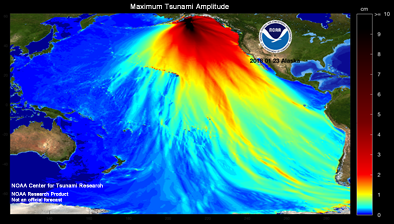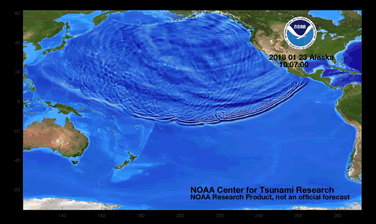|
NOAA NCTR research product
Not an official forecast |
Kodiak, Alaska Tsunami, January 23, 2018
Main Event Page
|
The Kodiak, Alaska tsunami was generated by a Mw 7.9 earthquake (56.046°N 149.073°W), at 2018-01-23 09:31:42 UTC (according to the USGS). The first peak of tsunami was detected at DART 46409, located 90 km southeast from the epicenter, about 10 min after the earthquake. 78 minutes later, a tsunami peak of 10 cm was observed by the tide gauge at Kodiak, Alaska. Model results shown below were created with the NOAA forecast method using MOST model with the tsunami source inferred from the seismic information and the DART data. The graphics display preliminary modeling analysis, showing qualitative and quantitative information about the tsunami, including tsunami wave interaction with ocean floor bathymetric features, and neighboring coastlines. Tsunami model amplitude information is shown color-coded according to the scale bar.
|
||||
Preliminary Model
Comparison of the January 23, 2018 Kodiak, Alaska tsunami recorded at tsunameter/DARTs and tide gauges with model results. Several model tsunami sources centered at the epicenter were derived from the USGS W-phase solution. Tsunami propagation solutions from these sources were computed on the fly while the tsunami was still progressing. The presented solution was obtained as a linear combination of the sources that fits best the tsunami records from the DARTs.
- DART® comparisons with model data
- Composite plot: DARTs 46409, 46410, 46403, 46402, 46408, 46413, 46419, 46411, and 51407
- Coastal sea-level gauge comparisons with model data
It is noted that all above model results are preliminary. The tsunami source is estimated from inversion of observed waveforms at DARTs using limited number of high-angle strike-slip unit sources. The discrepancies between model results and tide gauge observation are mostly due to our limited knowledge of the earthquake/tsunami source configuration at this point and limited number of unit sources used in the inversion.
Disclaimer: The models on these pages show the results of ongoing research to enhance tsunami science and to improve NOAA operational tsunami forecasts. These products were developed during or shortly after the tsunami event, are intended for research use, and are not an official forecast. They should not be used as the basis of any public or private policy decisions. Please contact NCTR to find if there are more detailed follow-on analysis results.
For media inquiries:
When using information from this page, please credit NOAA / PMEL / Center for Tsunami Research


